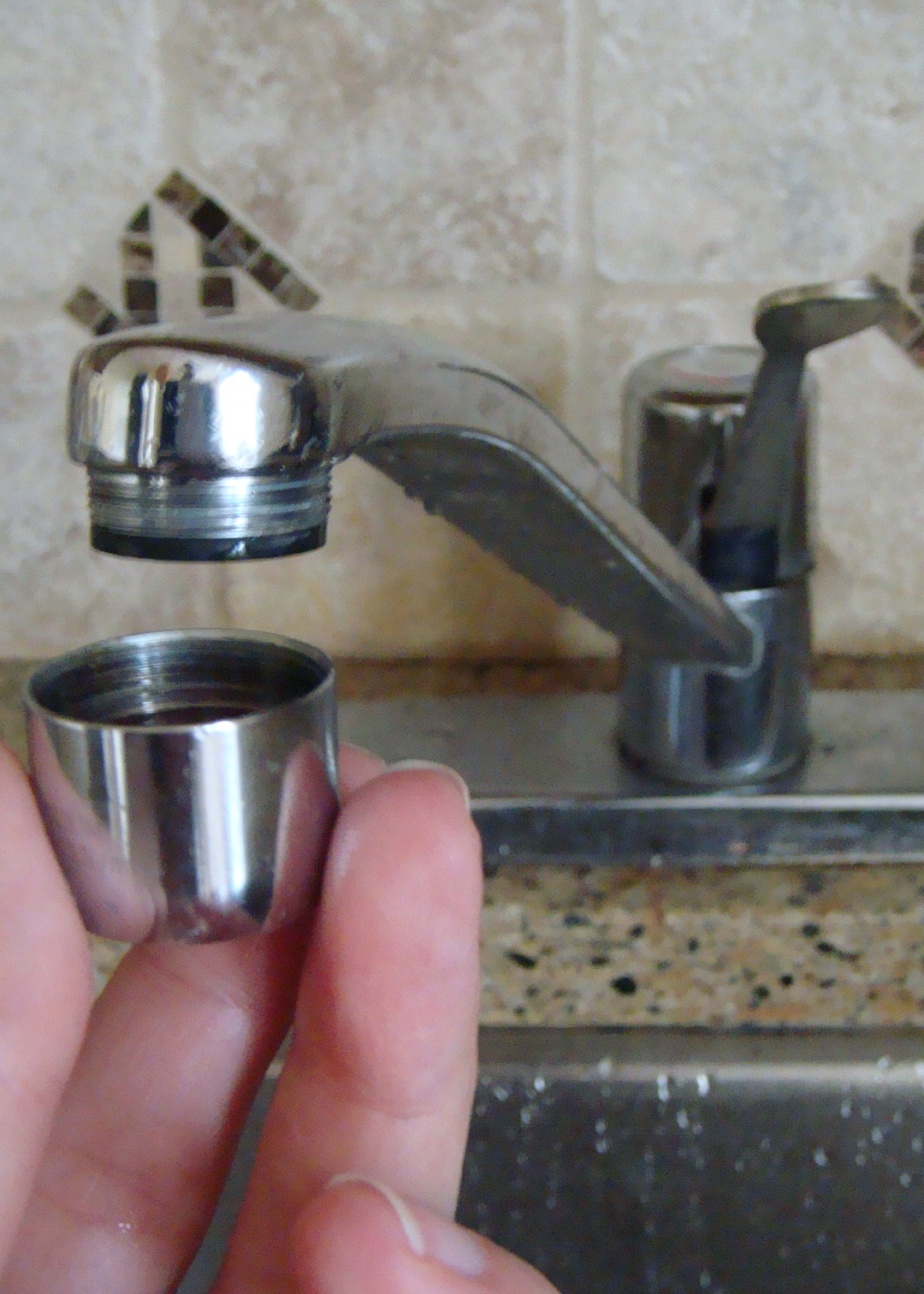One of the most common reasons for no water in the kitchen sink is clogged pipes. Over time, debris, food particles, and grease can build up in the pipes, causing them to become blocked. This can prevent water from flowing freely and result in a lack of water in the sink. If you notice that your sink is draining slowly or not at all, it's likely that you have a clog in your pipes. You can try using a plunger or a plumbing snake to dislodge the blockage. However, if the clog is severe, it's best to call a professional plumber to clear it out.1. Clogged Pipes in the Kitchen Sink
Another reason for no water in the kitchen sink could be a broken faucet. Over time, faucets can wear out and develop leaks, which can affect the water flow. If you have a broken faucet, it's important to have it repaired or replaced as soon as possible to avoid further damage to your sink and water supply. You can try tightening the faucet or replacing the washers to see if that resolves the issue. However, if the problem persists, it's best to call a plumber to fix the faucet professionally.2. Broken Faucet in the Kitchen Sink
If you suddenly have no water in the kitchen sink, it's possible that the water shut off valve has been turned off. This valve is usually located under the sink and can accidentally get turned off while doing other tasks in the kitchen. Make sure to check the position of the water shut off valve and turn it back on if it's been accidentally shut off. If the valve is damaged or not functioning properly, it's best to have it replaced by a professional.3. Water Shut Off in the Kitchen Sink
Leaking pipes can also cause a lack of water in the kitchen sink. If you notice any water dripping or pooling under your sink, it could be a sign of a leak in the pipes. This can not only affect the water flow but also lead to water damage and mold growth. If the leak is minor, you can try using plumber's tape or epoxy putty to seal it. However, if the leak is significant, it's best to call a plumber to repair or replace the damaged pipes.4. Leaking Pipes in the Kitchen Sink
Another issue that can result in no water in the kitchen sink is low water pressure. This can be caused by various factors such as a clogged aerator, a malfunctioning water valve, or an issue with the water supply line. You can try removing and cleaning the aerator to see if that improves the water pressure. If not, it's best to call a plumber to identify and fix the root cause of the low water pressure.5. No Water Pressure in the Kitchen Sink
In colder climates, frozen pipes can be a common cause of no water in the kitchen sink. When water freezes inside the pipes, it can cause them to burst and disrupt the water flow. This can also lead to costly repairs and water damage. If you suspect that your pipes are frozen, you can try using a hairdryer or hot water to thaw them out. However, it's crucial to call a plumber to inspect the pipes and make sure they haven't been damaged by the freezing.6. Frozen Pipes in the Kitchen Sink
If your kitchen sink is not receiving any water at all, it's possible that there is a problem with the water supply line. This line connects your sink to the main water supply and can become damaged or disconnected over time. If you are comfortable doing so, you can check the water supply line for any visible damage or loose connections. Otherwise, it's best to call a plumber to inspect and repair the line to restore water flow to your sink.7. Faulty Water Supply Line in the Kitchen Sink
The aerator is a small mesh screen located at the end of the faucet, and it helps to regulate the water flow and reduce splashing. Over time, debris and mineral buildup can clog the aerator and affect the water flow. You can try removing and cleaning the aerator with a toothbrush and some vinegar to remove the buildup. If the aerator is damaged, it's best to replace it with a new one to restore proper water flow in your kitchen sink.8. Blocked Aerator in the Kitchen Sink
The water valve controls the water flow to your sink, and if it malfunctions, it can result in no water in the kitchen sink. This can be caused by various issues such as wear and tear, mineral buildup, or a damaged valve. If you suspect that the water valve is the problem, it's best to call a plumber to replace it. Attempting to fix a faulty water valve on your own can lead to further damage and potentially bigger repairs.9. Malfunctioning Water Valve in the Kitchen Sink
If your sink has a low water level, it can be challenging to perform everyday tasks such as washing dishes or filling pots with water. This can be caused by a clogged drain, a low water pressure, or a faulty faucet. You can try cleaning the drain and removing any debris or blockages to improve the water level. If the problem persists, it's best to call a plumber to identify and fix the underlying cause. In conclusion, there are various reasons why your kitchen sink may not have any water. By understanding these common issues and knowing when to call a professional, you can ensure that your sink always has a steady supply of water for your everyday tasks. Remember to perform regular maintenance on your sink and plumbing to prevent these issues from occurring in the future.10. Low Water Level in the Kitchen Sink
The Importance of a Functional Kitchen Sink in House Design

Ensuring Proper Functionality in the Kitchen
 A kitchen sink is an essential element in any household, playing a crucial role in meal preparation and clean-up. It is not only a practical feature but also a design element that can enhance the overall look of a kitchen. However, when there is no water in the kitchen sink, it can quickly become a source of frustration and inconvenience. In this article, we will explore the importance of a functional kitchen sink in house design.
A kitchen sink is an essential element in any household, playing a crucial role in meal preparation and clean-up. It is not only a practical feature but also a design element that can enhance the overall look of a kitchen. However, when there is no water in the kitchen sink, it can quickly become a source of frustration and inconvenience. In this article, we will explore the importance of a functional kitchen sink in house design.
Water as a Vital Resource
 Water
is a fundamental resource that we use every day in our homes. From cooking and cleaning to personal hygiene, we rely on water to carry out our daily tasks. As such, a functional kitchen sink is crucial in ensuring that we have a steady supply of water in our homes. Without it, simple tasks such as washing dishes or filling up a glass of water become difficult and time-consuming.
Water
is a fundamental resource that we use every day in our homes. From cooking and cleaning to personal hygiene, we rely on water to carry out our daily tasks. As such, a functional kitchen sink is crucial in ensuring that we have a steady supply of water in our homes. Without it, simple tasks such as washing dishes or filling up a glass of water become difficult and time-consuming.
Design and Aesthetics
 Apart from its functional purposes, a kitchen sink also plays a significant role in the overall design and aesthetics of a kitchen. With the rise of open-concept living spaces, the kitchen has become a focal point in many homes. A well-designed kitchen sink can add to the overall ambiance and appeal of a kitchen. Additionally, a functional sink with the right faucets and finishes can elevate the design and add a touch of elegance to the space.
Apart from its functional purposes, a kitchen sink also plays a significant role in the overall design and aesthetics of a kitchen. With the rise of open-concept living spaces, the kitchen has become a focal point in many homes. A well-designed kitchen sink can add to the overall ambiance and appeal of a kitchen. Additionally, a functional sink with the right faucets and finishes can elevate the design and add a touch of elegance to the space.
Efficient Workflow
 A functional kitchen sink is essential in ensuring an efficient workflow in the kitchen. With a steady supply of water, meal preparation becomes more manageable and cleaning up becomes a breeze. This is especially important for those who love to cook and spend a lot of time in the kitchen. A dysfunctional sink can disrupt the flow of cooking and make it challenging to keep the kitchen clean and organized.
A functional kitchen sink is essential in ensuring an efficient workflow in the kitchen. With a steady supply of water, meal preparation becomes more manageable and cleaning up becomes a breeze. This is especially important for those who love to cook and spend a lot of time in the kitchen. A dysfunctional sink can disrupt the flow of cooking and make it challenging to keep the kitchen clean and organized.
The Role of Plumbing in House Design
:max_bytes(150000):strip_icc()/water-overflowing-in-kitchen-sink-200553937-001-5797e6335f9b58461f5a6736.jpg) Plumbing
is a crucial aspect of house design that often goes unnoticed. However, it is the backbone of a functional home, and a malfunctioning plumbing system can cause significant problems. This is why it is vital to invest in high-quality plumbing materials and ensure that they are properly installed. A functional kitchen sink is dependent on a well-designed plumbing system, making it a vital consideration in house design.
In conclusion, a kitchen sink may seem like a small element in house design, but its importance cannot be overstated. From ensuring a steady supply of water to enhancing the design and efficiency of a kitchen, a functional sink is crucial in creating a functional and beautiful home. So, the next time you encounter a problem with your kitchen sink, remember its vital role in your house design and address the issue promptly.
Plumbing
is a crucial aspect of house design that often goes unnoticed. However, it is the backbone of a functional home, and a malfunctioning plumbing system can cause significant problems. This is why it is vital to invest in high-quality plumbing materials and ensure that they are properly installed. A functional kitchen sink is dependent on a well-designed plumbing system, making it a vital consideration in house design.
In conclusion, a kitchen sink may seem like a small element in house design, but its importance cannot be overstated. From ensuring a steady supply of water to enhancing the design and efficiency of a kitchen, a functional sink is crucial in creating a functional and beautiful home. So, the next time you encounter a problem with your kitchen sink, remember its vital role in your house design and address the issue promptly.



























/sink-pipe-under-wash-basin-119001607-75542e154b364e7bb52032249f293908.jpg)



































/how-to-install-a-sink-drain-2718789-hero-24e898006ed94c9593a2a268b57989a3.jpg)















:max_bytes(150000):strip_icc()/ac2-56a73c5c5f9b58b7d0e81846.jpg)



:max_bytes(150000):strip_icc()/clearing-a-blocked-faucet-aerator-2718807-07-b5a90554991f4bb69efb45a472df7f23.jpg)





























